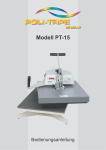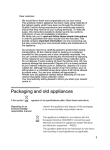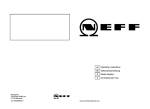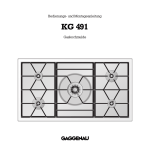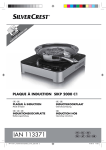Download Teka CGX 60 4G IS Cooktop User Manual
Transcript
INSTALLATION INSTRUCTIONS AND USE AND MAINTENANCE RECOMMENDATIONS FOR GAS HOBS EINBAUANLEITUNG FÜR GAS-GLASKOCHFELDER MIT BEDIENUNGS- UND PFLEGEHINWEISEN INSTRUCTIONS POUR L'INSTALLATION ET RECOMMANDATIONS D'UTILISATION ET DE MAINTENANCE DES CUISINIÈRES À GAZ CGX 60 4G IS - CGX 70 5G IS TR Índice / Inhalt / Table des matières / DE GB Introduction User Guide 4 5 Allgemeines Bedienungshinweise 4 21 Installation Positioning the hobs Positioning the oven Fixing the hob Connecting the gas Connecting the electricity Gas conversion 6 6 7 7 7 8 8 Einbau Einbau des Kochfelds Einbau des Herdes Verankerung Gasanschluss Netzanschluss Umrüstung auf eine andere Gasart 22 22 23 23 23 24 24 Technical Information Dimensions and powers Technical data 10 10 11 Technische Angaben Abmessungen und Leistung Technische Daten 26 26 27 Use and Maintenance Special requirements before first use Component parts of a gas burner Touch control panel user instructions Locking the sensor buttons of the hob Safety disconnection Safety against overheating Mechanism to protect against inadvertently turning the gas control knobs Component parts of an automatic control and safety system Using the hob Tips for correctly using burners Reminder Cleaning and care Maintenance 12 12 12 12 Bedienung und Pflege Maßnahmen vor Inbetriebnahme Brenneraufbau Sensorbedienung Sensor-Kindersicherung Sicherheitsabschaltung Überhitzungsschutz Mechanische Knebelsperre Thermoelektrische Zündsicherung Gebrauch des Kochfelds Hinweise zur sachgemäßen Bedienung der Brenner Wichtige Hinweise Reinigung und Pflege Wartung 28 28 28 28 30 30 30 31 31 32 Störungsbehebung 36 If something doesn't work 20 2 14 14 14 15 15 16 16 17 18 19 32 33 34 35 FR Présentation Guide d'utilisation 4 37 Installation Emplacement des plans de travail de cuisson Emplacement du four Ancrage du plan de travail de cuisson Connexion du gaz Connexion électrique Transformation du gaz 38 Information technique Dimensions et puissances Données techniques 42 42 43 Utilisation et Maintenance Conditions particulières avant la mise en service Éléments d'un brûleur Instructions d'utilisation de la commande tactile Blocage des capteurs du plan de travail de cuisson Déconnexion de sécurité Sécurité de surchauffes Système anti-ouverture accidentelle des commandes de gaz Composants d'un système automatique de contrôle et de sécurité Utilisation de la cuisinière Conseils pour la bonne utilisation des brûleurs Rappel Nettoyage et conservation Maintenance 44 38 39 39 39 40 40 44 44 44 46 46 46 47 47 48 48 50 51 52 Si quelque chose ne fonctionne pas 53 3 Introduction / Allgemeines / Présentation / Παρουσίαση 2 1 2 1 5 3 6 5 CGX 70 5G IS TR CGX 60 4G IS GB 1 2,580 Kcal/h - 3 Kw fast burner. GB 1 2,580 Kcal/h - 3 Kw fast burner. 2 1,500 Kcal/h - 1.75 Kw semi-fast burner. 3 1,500 Kcal/h - 1.75 Kw semi-fast burner. 4 860 Kcal/h - 1 Kw auxiliary burner. 5 3,010 Kcal/h - 3.5 Kw triple ring burner. 6 Burner control knobs. * All burners incorporate a pan support. * Maximum heat output: 9,450 Kcal/h - 11 Kw. * Maximum electrical power: 4 W. DE 1 Starkbrenner 2 580 Kcal/h - 3 kW 2 Normalbrenner 1 500 Kcal/h - 1,75 kW 3 Normalbrenner 1 500 Kcal/h - 1,75 kW 4 Hilfsbrenner 860 Kcal/h - 1 kW 5 Dreifachbrenner 3 010 Kcal/h - 3,5 kW 6 Knebel * Alle Brenner verfügen über einen Topfträgerrost. * Maximale Wärmeleistung: 9 450 Kcal/h - 11 kW * Maximale elektrische Leistung: 4 W FR 1 Brûleur rapide de 2 580 Kcal/h - 3 kW. 2 Brûleur semi-rapide de 1 500 Kcal/h - 1,75 kW. 3 Brûleur semi-rapide de 1 500 Kcal/h - 1,75 kW. 4 Brûleur auxiliaire de 860 Kcal/h - 1 kW. 5 Brûleur triple couronne de 3 010 Kcal/h - 3,5 kW. 6 Commandes de mise en marche des brûleurs. * Tous les brûleurs ont une grille. * Puissance calorifique maximum : 9 450 Kcal/h - 11 kW. * Puissance électrique maximum 4 W. 2 1,500 Kcal/h - 1.75 Kw semi-fast burner. 3 1,500 Kcal/h - 1.75 Kw semi-fast burner. 4 860 Kcal/h - 1 Kw auxiliary burner. 5 Burner control knobs. * All burners incorporate a pan support. * Maximum heat output: 6,450 Kcal/h - 7.5 Kw. * Maximum electrical power: 4 W. DE 1 Starkbrenner 2 580 Kcal/h - 3 kW 2 Normalbrenner 1 500 Kcal/h - 1,75 kW 3 Normalbrenner 1 500 Kcal/h - 1,75 kW 4 Hilfsbrenner 860 Kcal/h - 1 kW 5 Knebel * Alle Brenner sind mit einem Rost ausgestattet. * Maximale Wärmeleistung: 6 450 Kcal/h - 7,5 kW * Maximale elektrische Leistung: 4 W FR 1 Brûleur rapide de 2 580 Kcal/h - 3 Kw. 2 Brûleur semi-rapide de 1 500 Kcal/h - 1,75 kW. 3 Brûleur semi-rapide de 1 500 Kcal/h - 1,75 kW. 4 Brûleur auxiliaire de 860 Kcal/h - 1 kW 5 Commandes de mise en marche des brûleurs. * Tous les brûleurs ont une grille. * Puissance calorifique maximum : 6.450 Kcal/h - 7,5 kW. * Puissance électrique maximum 4 W. GR GR 4 4 3 4 Guide to Using the Instructions Booklet Dear Customer, Safety Instructions We are delighted that you have put your trust in us. Before first use, you should carefully read the installation and connection instructions. We are confident that the new hob that you have purchased will fully satisfy your needs. This modern, functional and practical model has been manufactured using topquality materials that have undergone strict quality controls throughout the manufacturing process. Before installing and using it, please read this Manual carefully and follow the instructions closely; this will guarantee better results when using the appliance. Keep this Instruction Manual in a safe place so that you can refer to it easily and thus abide by the Guarantee conditions. These hob models may be installed in the same kitchen furniture units as TEKA brand ovens. For your safety, installation should be carried out by an authorised technician and should comply with existing installation standards. Likewise, any internal work on the hob should only be done by TEKA's technical staff, including replacing the mains cable. Attention: When the burners are being used or have recently been used, some areas will be hot and can burn. Children should be kept well away. In order to benefit from this Guarantee, it is essential that you submit the purchase receipt together with the Guarantee certificate. You should keep the Guarantee Certificate or, where relevant, the technical datasheet, together with the Instruction Manual for the duration of the useful life of the appliance. It contains important technical information. 5 GB Installation Important Minimum distance to walls fig. 1 INSTALLATION AND SETUP SHOULD BE CARRIED OUT BY AN AUTHORISED TECHNICIAN ACCORDING TO CURRENT INSTALLATION STANDARDS. Positioning the hobs Depending on the model to be installed, an opening with the dimensions shown in figure 1 should be cut into the unit's worktop. Minimum ventilation distances The system for fixing the hob is intended for use with kitchen units with a thickness of 20, 30 and 40 mm. A shelf should be placed inside the kitchen unit; there should be a minimum distance of 20 mm between the lower part of the hob and the upper part of the shelf. The hobs described in this manual can only be installed with TEKA brand ovens. Fitting holes 57 5m The minimum distance between the cookware support surface and the lower part of the kitchen unit or the hood located above the hob should be at least 650 mm. If the hood's installation instructions recommend that the distance is greater than this, you should follow this advice. ax . W L 57 5m ax . The unit where the hob and oven will be located should be suitably fixed. W Warnings: L When hobs are handled before being installed, care should be taken in case there is any protruding part or sharp edge which could cause injury. When installing units or appliances above the hob, the hob should be protected by a board so that the glass 6 Mod.: CGX 60 4G IS Mod.: CGX 70 5G IS TR The dimensions L and W are in the table "Dimensions and characteristics" in the Technical Information section. GB cannot be damaged by accidental blows or heavy weight. fig. 2 If the glass breaks or cracks, the hob should immediately be disconnected from the electric current in order to avoid the risk of electric shock. The glues used in manufacturing the kitchen unit and on the decorative laminates and on the laminates that are part of the worktop surface should be made to tolerate temperatures of up to 100ºC. TEKA does not assume any responsibility for any malfunction or damage caused by faulty installation. PLEASE REMEMBER THAT THE GUARANTEE DOES NOT COVER THE GLASS IF IT SUFFERS A VIOLENT BLOW OR IF IT IS USED IMPROPERLY. Positioning the oven Please see the corresponding manual. Fixing the hob When the gap has been properly sized, the gasket (A) should be put on the lower side of the hob. Place the clips (D) as indicated in figure 2, fastening them to the holes of the lower part of the body by using the self-tapping screws provided (Ø 4,2 mm). If the thickness of the kitchen unit is equal to or less than 30 mm, use the self-tapping screws that are provided as a fastening accessory by putting them into the clip's round hole. This hole will be threaded as the screw is inserted into it, which should be done before fixing the clip to the hob. 20 mm 30 mm 40 mm Gasket Hob Screw Clip Note: It is essential that the gasket be placed under the brim of the hob. Failure to install it may cause the worktop to be exposed to high temperatures. Connecting the gas The gas exit pipe of the hob should be connected to the gas mains according to installation standards or regulations in force and it should be done by qualified technical staff (an authorised installer). Since it is an immobilised appliance, the gas connection for these hobs must be done using rigid piping for hobs to be used in the EC. The hob comes with a ½" diameter threaded connection as per EN ISO 228-1 or a ½" taper threaded connection as per EN 10226-1, in accordance with the regulations of the country where the hob is to be used. The gas exit pipe of the hob should be connected to the gas mains following basic guidelines for the installation of gas in inhabited buildings TEKA does not assume any responsibility for any malfunction or damage caused by incorrect or faulty installation. To avoid damaging the hob when tighte7 GB ning the gas pipe connection nut, a maximum grip torque of 300 cm * Kgf should be used. Once the gas connection has been carried out, check that it is properly tightened. If this is done using air, please remember that the test pressure should not be greater than 200 g/cm². If you do not have air, use soapy water to make sure that there are no leaks in the joints. It is absolutely unadvisable to carry out this check using a flame. Once the hob has been installed, make sure that the minimums of the burners are properly adjusted. To do so, light the burners and check that they do not turn off when turned quickly from the maximum to the minimum. Every time that the gas connection nut is removed, the washer should be changed. Connecting the electricity Before connecting the hob to the electric mains, check that the voltage and frequency of the mains matches what is shown on the hob's rating plate, which is located on the lower part of the hob, and on the guarantee or, where appropriate, the technical data sheet supplied, which should be kept together with this manual during the useful life of this appliance. The electric connection is made using an omnipolar switch or plug, where accessible, that is suitable for the intensity to be tolerated and that has a minimum gap of 3 mm between its contacts. This will ensure disconnection in case of emergency or when cleaning the hob. It should also have a proper earthing connection, in accordance with current regulations. The connection should include correct ear8 thing, in compliance with current norms. If the flexible supply cable fitted to the appliance ever needs to be changed, it should be replaced by TEKA's official technical service. Gas conversion Important! Any changes made to the appliance to convert it to a different type of gas should only be carried out by a qualified technician. Information for the Technical Service: whenever the type of gas or the appliance's pressure is changed, the new regulation plate should be placed on top of the old one so that the new features can be seen after the change. The tasks involved in conversion are: * Replace the injectors. * Adjust the minimums of the taps. The injectors required for each gas type are shown in table 1. Please follow these instructions to replace the injectors: 1 Remove the pan supports and the upper parts of the burner so that the injector can be seen. 2 Using a number 7 pipe spanner, remove the injectors and replace them with the new ones. Ensure that the injector is properly tightened in order to prevent gas from escaping. 3 Replace the pan supports and burners that were previously removed. When the injectors have been changed, adjust the minimums as follows: 1 Turn the burners on to their minimum. GB 2 Remove the controls of the taps by pulling firmly upward and remove the gasket. 3 Use a slim, grooved screwdriver to turn the screw that is next to the shaft of the gas tap (detail "A" in figure 3). 4 When properly adjusted, check that the flame does not go out when you turn the knob quickly from maximum to minimum. Table 1 TEKA INDUSTRIAL, S.A. will not accept liability for any hob malfunction if the gas conversion or the adjustment of the minimums of the burners has not been carried out by TEKA's Technical Service. Ø injector in 1/100 mm Burner Family Second Third Group H Group 3+ Triple ring 135 T 95 Fast 116 Y 85 Semi-fast 97 Z 66 Auxiliary 72 X 50 fig. 3 Front view of the gas tap 9 GB Technical Information Dimensions and powers Models CGX 60 4G IS Dimensions in mm Length 610 Width 510 Height 119 Thickness of the glass 4 Dimensions for positioning in the kitchen unit mm 553 Length 473 Width 73 Depth Power per burner and cooking element 3.5 Kw triple ring gas burner 3 Kw fast gas burner 1 2 1.75 Kw semi-fast gas burner 1 Kw auxiliary gas burner Electric Nominal power (W) Power supply voltage (V) Frequency (Hz) Gas Nominal Calorific Consumption (kw) 710 510 127 4 660* 473 73 1 1 2 1 1 4 4 220 / 240 V. 220 / 240 V. 50 50 7,5 11 * For granite worktops, the size may be 563 mm. 10 CGX 70 5G IS TR GB ventilation system device should be installed (mechanical ventilation hood). Technical data COMMON FEATURES FOR ALL MODELS WITH AUTOMATIC IGNITION The supply voltage and frequency will be as shown on the rating plate. COMMON FEATURES FOR THESE GAS MODELS Warnings: a) Before installation, make sure that the local supply conditions (the gas type and pressure) are compatible with the appliance's setup. b) The setup conditions for this appliance are written on the label (or the rating plate). c) This appliance should not be connected to a device for removing combustion` products. Intense and prolonged use of the appliance require complementary ventilation, such as opening a window, or more efficient ventilation, such as increasing the power of the mechanical ventilation, if there is one. You should keep the Guarantee Certificate or, where relevant, the technical datasheet, together with the Instruction Manual for the duration of the useful life of the appliance. It contains important technical information. Class 3 hob. Table 2 Country Category Spain II2H3+ Portugal II2H3+ It should be installed and connected in compliance with the current installation standards. Special attention should be paid to the regulations applying to ventilation. United Kingdom II2H3+ Switzerland II2H3+ Ireland II2H3+ Chez Republic II2H3+ The use of a gas cooking appliance produces heat and moisture at the site where it is installed. The kitchen should be provided with suitable ventilation: natural ventilation sources should be kept clear, a window should be opened or an effective mechanical Greece I3+ Hungary I2H Denmark I2H Norway I2H Finland I2H Table 3 Sweden I2H Rumania II2H3B/P Triple ring Burner Nominal Heat Rate kW Fast Semi-fast Auxiliary 3,5 3 1,75 1 G-20 (Nm3/h) 20 (mbar) G-30 (Kg/h) 29 (mbar) 0,33 0,29 0,17 0,10 0,25 0,22 0,13 0,07 G-31 (Kg/h) 37 (mbar) 0,24 0,21 0,13 0,07 Reduced calorific consumption Kw 1,55 0,77 0,47 0,33 Output % >52 >52 >52 – Nominal Rate* * Rate over Higher Heating Value (Hs ) 11 GB Use and Maintenance Special requirements before first use Touch control panel user instructions Before connecting the hob to the electric mains, check that the voltage and frequency of the mains matches what is shown on the hob's rating plate, which is located on the lower part of the hob, and on the guarantee or, where appropriate, the technical data sheet supplied, which should be kept together with this manual during the useful life of this appliance. CONTROL PANEL ELEMENTS (see fig. 5) This appliance is not designed to work through an external timer (not incorporated into the appliance itself) or a separate remote control system. Component parts of a gas burner 1 On/off sensor button. 2 Burner and residual heat selection lights. 3 Burner indicator symbols. 4 Lock function indicator symbol. 5 Indicator light of the activated locking option. 6 Touch control panel on light. NOTE: * Only visible when appliance is operating. fig. 5 Note: Every time that a burner is assembled, please make sure that all of the components are adjusted correctly. fig. 4 Actions are carried out using the on/off sensor button (1) on the control panel and the tap control. It is not necessary put pressure on the glass to use the sensor; by simply touching the sensor button with your finger, you will activate the desired function. Pan support Diffuser cover Diffuser crown Injector Injector holder 12 Each action is confirmed with a beep. GB 2 Turn on the gas at the mains or turn the gas cylinder tap. fig. 6 3 Turn and put pressure on the burner knob so that the gas ignites. 4 Place the knob in the desired position. 5 The burner selection light will go on. The control panel has marked zones (A) that indicate the control knob that corresponds to each burner. Indicator of the burner being used Off position Maximum gas position Use flat-bottomed cookware and make sure that they sit squarely on the pan support, so that the cookware does not slip when food boils (do not use cookware with a concave or convex base). Minimum gas position TURNING ON THE APPLIANCE Whenever you connect the hob to the electrical mains for the first time, the lock function will be activated. To deactivate this function, see the section "Locking the hob sensor". 1 Touch the on sensor button least one second. (1) for at The next action must be taken within three minutes; otherwise, the touch control panel will automatically turn off. IGNITING THE BURNERS Once the touch control panel has been activated by using the sensor button (1), you can turn on the chosen burners. To do so, please do as follows (see fig. 6): 1 Make sure that the knobs are in the correct position. If an error occurs while igniting the burner, the burner will be deactivated after the safety time has elapsed (10 seconds). These hobs may not be lit using matches. Table with diameters of cookware according to the type of burner Power (in Watts) Diameter of cookware (in cm) Triple ring 3500 24 _: 26 Fast 3000 20 _: 22 Semi-fast 1750 16 _: 18 Auxiliary 1000 10 _: 14 Burner RE-LIGHTING If one of the burners accidentally turns off with the tap connected (i.e. turned), the system will automatically attempt to relight the burner for 10 seconds. 13 GB EMERGENCY SHUT-OFF The appliance may be turned off at any time by touching the general on/off sensor button (1). After doing so, turn the control knobs back to the initial position. TURNING OFF THE BURNER 1 Use the corresponding control knob to lower the power to the off position (B in fig. 6). Once the burner has been turned off, its light (2) will go on, which indicates that there is residual heat, i.e. that it is still hot and, therefore, it may cause burns. TURNING OFF THE APPLIANCE 1 Once all of the control knobs are in the off position (B in fig. 5), touch the general on/off sensor button (1) If the light of a burner (2) (see fig. 5) is flashing, it means that the control knob should be turned again to the off position. Locking the sensor buttons of the hob If the hob is disconnected and you touch the on/off sensor button (1) for more than 4.5 seconds, you will lock the burners. This will allow you to prevent undesirable operations from occurring accidentally and it will make it so children are not able to manipulate the device. Once the sensor button lock has been activated, the indicator light (5) will turn on. If you try to light a burner when this function is activated, its light (2) will flash, indicating that it is an erroneous operation. To deactivate the lock function, touch the 14 on/off sensor button (1) again for at least 4.5 seconds. The lock indicator light (5) will turn off, the light (6) will stay on and it will be possible to once again use the control knobs. The lock only works on the electronic system; it does not affect the mechanical movements of the taps of each burner. This means that, when the lock function is activated, gas will come out when pressing on the control knobs. Safety disconnection MAXIMUM OPERATION TIME If one or more burners are left on, they will disconnect automatically after six hours. Safety against overheating The hob is protected against overheating of the electronic system, which could damage it. The entire hob will turn off if the temperature of the electronic system exceeds 105º C, and it will begin functioning again normally when the temperature decreases to 95º C. Warnings: You should periodically clean the ignition unit very carefully (ceramic and electrode) in order to prevent ignition problems. Also make sure that the openings of the burners are not obstructed. When the burners are being used or have recently been used, some areas of the hob will be hot and can burn. Children should be kept well away. GB For safety reasons, we recommend that you follow the instructions provided by the gas company when closing the supply tap when the hob is not in use. If the smell of gas is detected, the hob's gas intake tap should be shut off and the room should be ventilated. In addition, the gas installation and the hob should be checked by a specialised technician. The automatic lighting device should not be used for more than 15 seconds. If the burner does not light during this time, stop attempting to light it and open the door of the room and/or wait for at least one minute before trying to light the burner again. If the flame of the burner goes out accidentally, close the corresponding control knob of the burner and do not try and light the burner again for at least one minute. The appliance is not designed to be used by people (including children) with reduced physical, mental or sensory abilities. It should also not be used by people that do not have experience handling the appliance or who do not have knowledge of the appliance, unless they are supervised by a person who is in charge of their safety. Children should not be allowed to play with the appliance. Mechanism to protect against inadvertently turning the gas control knobs trol knobs from turning freely from the off position to the on position (and, therefore, prevents gas from accidentally escaping from the burners) if the control knob has not previously been pressed down. If at any time while using the hob you notice that a control knob can be turned from the off position without it needing to be pressed down beforehand (for example: because of dirt which may have got into and accumulated in the gas taps) you should, for your own safety, quickly notify the technical service so that the problem can be rectified. Component parts of an automatic control and safety system On these hobs with the safety feature, the gas cut-off device is made up of the following elements: * The safety tap * The safety thermocouple, next to the burner. * The thermocouple-control card connection. * The control card-tap connection The thermocouple sends an electric signal to the control card, which identifies whether or not the burner has a flame. Once the control card has processed the data, it sends another electric signal to the tap so that it opens and allows gas to enter. If the burner turns off, the absence of a flame will be detected by the thermocouple, which, since it is not sending a signal to the control card, will re-light the burner (10 seconds). If this does not work, the control card will send a new signal to the tap to cut-off the gas. The gas taps are equipped with a mechanical systems that prevents the con15 GB fig. 7 Suggestions for using the burners effectively * Fast burners should not be used with cookware that has a small diameter, because part of the flame will spread away from the cookware and thus reduce performance significantly. (See fig. 9). Safety thermocouple Thermocouple-tap connection Connection to the sparking unit Spark plug Ceramic Electrode Safety tap fig. 9 Bien Mal Using the hob * If the glass is broken or cracked, turn all of the control knobs of the hob to the off position as well as the gas intake tap and disconnect the electrical current. Contact TEKA'S Technical Service. * Do not keep items on the glass surface. * Do not leave aluminium foil, tinfoil or plastic wrap on the glass surface. * In these five-burner models, large cookware should be placed on the central burner in order to prevent it from reflecting heat on the kitchen unit worktop. fig. 8 16 * The burners should not be operated without there being cookware on them, or gas will be wasted and the pan support will heat up excessively. * When the burners are in operation, they should not to be exposed to strong draughts, because of the loss of heat output. * If the burner makes the cookware smoky or if the tip of the flame is yellow, the burner should be cleaned. If the problem persists, you should contact the Technical Assistance Service in order to adjust the primary air intake or clean the gas piping. * Cookware placed on the burners should not jut out past the edge of the hotplate, because the effect of the flame being reflected from the cookware can damage hobs with plastic surfaces. * Use pans with a flat base. Reminder GB Do not use small cookware on large burners, because the flame will spread away. Use proper cookware for each burner in order to better utilise the heat. Do not place cookware misaligned over the centre of the burner. Place the cookware properly centred over the burner. Do not use instruments that reflect excessive heat downward directly over the pan support. To use griddles, clay casseroles or cookware that reflect heat downward, use the pan support accessory. Do not place cookware directly on the burner. Place cookware on the pan support. Do not use sharp object over the hob. After using the pan supports, it is a good idea to clean them once they have cooled. Do not use excessive weights or bang the hob with a heavy object. Handle cookware with care over the hob. 17 GB Cleaning and care To properly care for the glass, you should clean it with suitable products and instruments when the glass is cold. If you clean it every time it is used, it will be easier to clean and you will keep dirt from different cooking sessions from getting stuck. The degree of soiling should be taken into account when cleaning the glass. Please clean glass as indicated below: * When soiling is light and does not stick, it can be cleaned using a damp cloth and a mild detergent. * Heavy stains or grease stains should be cleaned using a cleaning agent suitable for glass (example: Clen Vitrocerámicas). * Sticky stains that have been burned in can be removed by using a scraper with a razor blade. * Plastic objects, sugar or food with a high sugar content that are melted onto the hob should be removed immediately while hot by using a scraper * Under no circumstances should you use abrasive cleaning agents or products that scratch, such as oven cleaning sprays, rust stain removers or sponges or scouring pads with a hard surface. * Do not slide cookware over the glass; this may cause scratching. * Make sure that cookware is not left without liquid. The heat accumulated in the bottom of the cookware could cause damage to the burner or to the hob glass. * The glass will withstand bangs from large cookware that does not have sharp edges. Please be careful with impacts from small, sharp utensils. Do not strike the edge of the glass with cookware as this may cause irreparable damage to the glass. * Do not spill cold liquids on the glass or the burners when they are hot. 18 * Do not stand or lean on the glass. It may break and cause injury. To clean and care for other components, please follow these guidelines: * Pan supports should be cleaned with a non-abrasive scouring pad after they have cooled off. * Burners should be cleaned periodically, particularly the grooves in the burner heads. To do so, soak them in warm, soapy water and scrub them with a scouring pad or with a stiff brush. * Do not clean the enamelled burner covers when they are still hot. Damage can be caused by abrasive products, such as vinegar, coffee, milk, saltwater and tomato juice, as a result of prolonged contact with the enamelled surfaces. * When the burners have been dismantled for cleaning purposes, care should be taken to prevent liquids or other objects from entering the nozzle unit. * Do not use cleaning products that attack aluminium, such as caustic soda, oil, etc. * Every time you assemble a burner, check that all of its component parts fit together correctly. A badly positioned element may cause the hob glass to overheat * You should periodically clean the ignition unit very carefully (ceramic and electrode) in order to prevent lighting problems. Also make sure that the openings of the burners are not obstructed. GB Maintenance No part of this appliance requires periodic lubrication. The burners are operating correctly when they have a blue-green, stable flame. If the tips of the flame are yellow, the burners should be cleaned thoroughly. If the problem persists, contact the Technical Service. To ensure that the gas installation is properly sealed and that the burners continue to work correctly, the hob must be serviced by the Specialised Technical Service at least once every year. Note: The symbol on the product or on its packaging indicates that this product may not be treated as household waste. Instead, it should be handed over to the applicable collection point for the recycling of electrical and electronic equipment. By ensuring that this product is disposed of correctly, you will help prevent potential negative consequences for the environment and human health which could occur if this product is not handled correctly. For more detailed information on the recycling of this product, please contact your local city office, your household waste disposal service or the shop where you purchased the product. Any necessary alternation or set-up of the appliance must be carried out by authorised technical staff. 19 GB If something doesn't work Before calling the Technical Service, please check the following possible causes and solutions: Problem Possible cause There is no spark when the automatic lighting control is pressed The voltage does not reach the plug Possible solution Check and repair the power mains There is a spark but the burner doesn't light The spark plug and the part of the burner where the spark should be is soiled or greasy Clean the end of the spark plug and the burner Gas is not reaching the hob Check that the gas cylinder tap is properly open The gas burners do not light If it is piped gas, open the gas tap Sparks fly occasionally Low adjustment of the minimum Increase the flow by adjusting the minimum of the tap The gas burners make the cookware dirty 20 The burner openings are dirty Clean the burner openings Injector or injector holder is dirty Clean the injector holder and injector without using anything which could damage or alter the diameter of the gas outlet opening





















